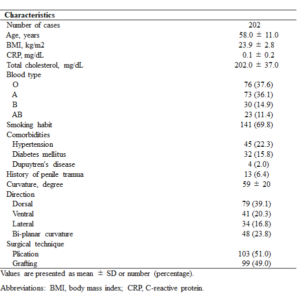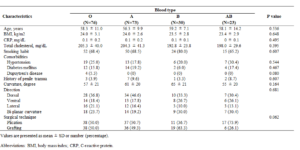ABO Blood Type and Risk of Peyronie’s Disease in Japanese Males

Key Points
- A survey of Japanese patients with PD revealed that susceptibility to the disease differs depending on the patient’s ABO blood type.
- Type O was found to be the most susceptible to PD, with 2.02 times greater odds than type B, which was the least susceptible.
- This study will not only contribute to the elucidation of the etiology of PD but is also expected to assist in the prevention of the disease through understanding possible risk factors.
A breakthrough discovery by Dr. Yozo Mitsui and his colleagues from the Department of Urology, Toho University Faculty of Medicine uncovers the association between the different ABO blood types and susceptibility to Peyronie’s disease (PD). PD is a benign condition in which a lump on the penis causes penile deformation and pain during erection. To date, the cause of PD has been undetermined. The results of this study are expected to provide direction in elucidating the etiology of PD as well as its prevention. The results will be published online in the journal The World Journal of Men’s Health on January 1, 2022. Currently, the results are available as a Forthcoming Article from November 3, 2021.

Professor
Department of Urology
- A survey of Japanese patients with PD revealed that susceptibility to the disease differs depending on the patient’s ABO blood type.
- Type O was found to be the most susceptible to PD, with 2.02 times greater odds than type B, which was the least susceptible.
- This study will not only contribute to the elucidation of the etiology of PD but is also expected to assist in the prevention of the disease through understanding possible risk factors.

Fig. 1. Blood group distribution in different groups:The distribution of ABO blood types is displayed as pie charts in Figure 1. That in Figure 1A shows the distribution in the general Japanese population, with O, A, B, and AB accounting for 29.2%, 38.7%, 22.2%, 9.9%, respectively [16], thus A is most common followed in order by O, B, and AB in Japan, as compared to O followed by A, B, and AB worldwide. In the present control group, type A had the highest proportion at 37.9%, followed by type O at 29.1%, type B at 23.2 %, and type AB at 9.8%, which were quite in line with that of the general Japanese population (Figure 1B). On the other hand, the PD patients most often had O type at a rate of 37.6% (Figure 1C), which was significantly higher than that of the control group (p=0.018). In addition, the proportion of B type in the PD cases was 14.9%, significantly lower as compared to the control group at 23% (p=0.009). The proportions for type A and AB in the patient group were not different from those of the general Japanese population or control group.
The World Journal of Men’s Health (Online edition: January 1, 2022)
Article title
ABO blood type and risk of Peyronie’s disease in Japanese males
Author(s)
Yozo Mitsui*, Hideyuki Kobayashi, Fumito Yamabe, Koichi Nakajima, Koichi Nagao (*Responsible Author)
DOI No. 10.5534/wjmh.210126
READ MORE RESEARCH NEWS - MEDICINE
Undergraduate Programs
– Medicine
– Pharmaceutical Sciences
– Science
– Nursing
– Health Science
Graduate Programs
–Medicine
–Pharmaceutical Sciences
–Science
–Nursing
RESEARCH
– News
– Guidelines & Policies
– Support Offices
– Facilities
– Security Export Control
Non-Degree Programs
– Clinical Elective Program
– International Physician Observership Program








